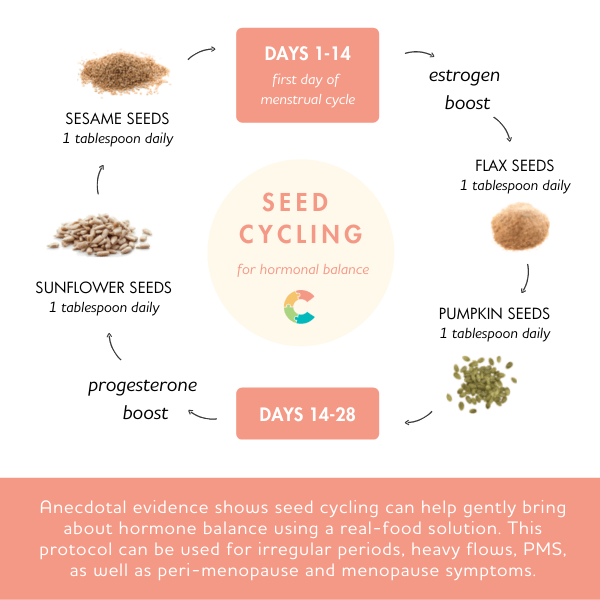Seed Cycling: A Food-First Approach to Hormone Balance
More and more women are struggling with hormonal imbalance. Excruciating cramps and bloating, acne, brain fog, mood swings, and low libido are driving many women to seek holistic remedies that will help them alleviate these uncomfortable symptoms and return to feeling the best they can. Our hormonal balance is delicate and easily impacted by internal and external factors like stress, food, nutrient deficiencies, environmental toxins, beauty products, and household cleaning supplies. Thankfully, there are many ways to support your hormone balance through food-first approaches, like seed cycling.
As the topic of hormonal health becomes more mainstream, seed cycling has gained a lot of popularity as a way to support hormonal balance. It’s an easy and inexpensive way to support your hormones with a food-first approach by consuming specific seeds during specific times of the menstrual cycle. Interested? Keep reading to learn more about what it is, how it works, and exactly how to do it.
Our hormonal balance is delicate and easily impacted by internal and external factors like stress, food, nutrient deficiencies, environmental toxins, beauty products, and household cleaning supplies.
What is Seed Cycling?
Seed cycling is a holistic approach to hormone balance that is thought to support the body in balancing estrogen and progesterone throughout the menstrual cycle. Its many hormone balancing benefits include regulating menstrual cycles, reducing symptoms of PMS like cramping, headaches, and bloating, reducing acne, and reducing symptoms of menopause like mood swings, hot flashes, and night sweats.
Engaging in seed cycling is quite easy and straightforward, making it a great option for those looking for easy-to-implement, food-based solutions. But before we get into the nitty-gritty of exactly how to do it, it’s important to understand the menstrual cycle phases and how these seeds can be used to support the hormones in each phase. The menstrual cycle is broken down into four phases, but for the purpose of seed cycling, we will be specifically focusing on two—the follicular phase and the luteal phase.  The Follicular Phase: Days 1 - 14
The Follicular Phase: Days 1 - 14
The first 14 days of the menstrual cycle (beginning on day 1 of your period) are considered the follicular phase. During this phase, estrogen levels rise while progesterone levels remain low as the body prepares for an egg to be released.
The Luteal Phase: Days 15 - 28
The following 14 days of the menstrual cycle create the luteal phase. During this phase, estrogen levels slowly decline as progesterone levels rise, peak, and then drop. It is also during this phase that the body prepares for a potential pregnancy.
The body is pretty picky about its hormone levels, and any imbalance between hormones like estrogen and progesterone can create some common and uncomfortable symptoms. These include but are not limited to menstrual cramps, anovulation, irregular cycles, heavy bleeding, amenorrhea (absence of menstruation), acne, migraines, and much more.
How Does Seed Cycling Work?
Seed cycling is commonly accomplished by eating specific seeds during certain phases of the menstrual cycle. During the Follicular phase, women should consume one to two tablespoons each of pumpkin seeds and freshly ground flax seeds each day. These seeds are thought to help balance estrogen levels as they contain nutrients called “phytoestrogens.” Phytoestrogens are plant-based estrogen sources that help regulate estrogen levels and manage estrogen receptors in the body. Symptoms of estrogen imbalances that might suggest these seeds could provide support include irritability, heavy menstrual cycles, digestive distress, low libido, and breast cysts.
During the Luteal phase, women should consume one to two tablespoons each of ground sunflower seeds and sesame seeds each day until the beginning of their next period. These seeds are helpful during this phase as they both are good sources of the mineral selenium, which is thought to play a role in sex hormone production in the luteal phase.
Symptoms of estrogen imbalances that might suggest these seeds could provide support include irritability, heavy menstrual cycles, digestive distress, low libido, and breast cysts.
Who Should Practice Seed Cycling?
Many women would benefit from incorporating seed cycling into their daily routine regardless of age and menstrual status. We have already covered many benefits for those experiencing a regular menstrual cycle, but it is important to note that women who experience amenorrhea, are menopausal, or are postmenopausal can experience the benefits that come with seed cycling as well. For individuals who do not have a regular menstrual cycle, it’s often recommended to use the phases of the moon to guide their seed cycling phases. For example, day one of the cycle will start on the new moon and continue for 14 days, followed by phase two.
How to Incorporate Seed Cycling
Incorporating seed cycling into your daily life can be equally as easy as it is delicious. Some of our favorite ways to consume these seeds include adding them to oatmeal, mixed in with greek yogurt, blended into smoothies, or even as a unique topper for salads.
Are you ready to kick your symptoms of hormone imbalance and want a little extra guidance? Our team of nutritional therapy practitioners provide food and supplement recommendations that can have you feeling like yourself again. Become a member of Curated to take advantage of their expertise and get a helping hand along the way.
About the Author
Emily Alexander, M.Ed, FNTP—Emily is a Nutritional Therapy Practitioner with Curated Wellness. She is passionate about supporting others in their journey to improve their relationship with food and their body through gentle nutrition, and is a firm believer that understanding the bio-individual components of nutrition is one of the best ways to do so. Emily completed her Master’s of education in health education and promotion with a concentration in eating disorders, and draws from both her educational background and life experience to help her clients improve their energy, understand their bodies, boost their athletic potential, and break down diet myths one at a time. Read more about Emily.
The information presented on this website is intended for educational purposes only. Statements within this site have not been evaluated or approved by the Food and Drug Administration. This content is not intended to diagnose, treat, cure, or prevent any specific condition or disease, nor is it medical advice and should not be considered a substitute for professional medical expertise. Readers of this content are advised to consult their doctors or qualified health professionals regarding specific health conditions or concerns. One should always consult a qualified medical professional before engaging in any dietary and/or lifestyle change or new health program. Curated Wellness does not take responsibility for any health consequences of any person or persons following the information in this educational content.
References
-
Phipps, W. R., Martini, M. C., Lampe, J. W., Slavin, J. L., & Kurzer, M. S. (1993). Effect of flax seed ingestion on the menstrual cycle. The Journal of clinical endocrinology and metabolism, 77(5), 1215–1219. https://doi.org/10.1210/jcem.77.5.8077314
-
Cetisli, N. E., Saruhan, A., & Kivcak, B. (2015). The effects of flaxseed on menopausal symptoms and quality of life. Holistic nursing practice, 29(3), 151–157. https://doi.org/10.1097/HNP.0000000000000085
-
Brooks, J. D., Ward, W. E., Lewis, J. E., Hilditch, J., Nickell, L., Wong, E., & Thompson, L. U. (2004). Supplementation with flaxseed alters estrogen metabolism in postmenopausal women to a greater extent than does supplementation with an equal amount of soy. The American journal of clinical nutrition, 79(2), 318–325. https://doi.org/10.1093/ajcn/79.2.318
-
DIETARY PHYTOESTROGENS | Annual Review of Nutrition (annualreviews.org)
-
Selenium status, sex hormones, and thyroid function in young women - ScienceDirect







